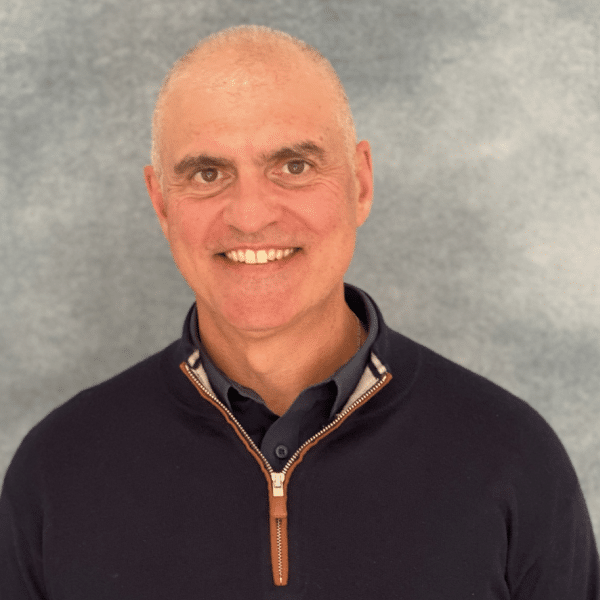How to Validate New Products with Rapid Testing
Brandon Cornuke
VP of Marketing at MAGNET
Hear how different companies – from startups to enterprises – traditionally validate and launch new-to-market products.
Gain great insights on what works, what doesn’t and where there are opportunities to improve the process. Also, learn ways to sell the idea of iterative testing to leadership at any business.
Brandon Cornuke, VP of Marketing at MAGNET, joins our host Tessa Burg, VP of UX & Technology Strategy at Tenlo, to share his experiences and tips.
Highlights From This Episode:
- Discovering who your customer is and what problem you're solving for them
- Defining the value your product provides and how it needs to be positioned
- Quickly learning if the assumptions you make are correct
Tessa Burg: Today’s episode is with guests, Brandon Cornuke. We’re going to talk about how to validate new products with rapid testing. We’re broadcasting today live from Cleveland, Ohio. Brandon will share his experiences from startups to enterprises and how businesses traditionally validate and launch new to market products. We’ll learn a little bit about what works, what doesn’t and where are there opportunities to improve the process. Brandon, thanks for joining us.
Brandon Cornuke: Thank you for having me, Tessa.
Tessa Burg: So let’s start a little bit with your career journey. I know you’ve worked at a lot of different companies, from startups to enterprises, and led different innovation teams. Tell us a little bit about what you’ve learned along the way and what are some insights our listeners can take.
Brandon Cornuke: So I’ll give you a quick spin through of my background just to give everybody a sense for how I got to be doing what I’m doing. Started out in consulting, did that for five years, did IT strategy stuff, decided that was taking little pieces of my soul away so I went to business school. And when I was at business school, met a friend who was really passionate about starting a business, and I was lucky enough to join him and we built a consumer products business while I was there studying. It is a personal care product. It was the first spray on body powder introduced to the market. So if anybody’s out there is familiar with Gold Bond that you spray on your skin, we launched the first one. We did that for two years and then a couple of years afterwards, continued to pursue that. Eventually got ground into dust by Chattem that actually owns gold bond and various competitors that ended the space. Learned a ton, loved what we were doing, had a blast, of course found a real passion for product development.
After that, I spent some time at Target learning retail and all the things that I screwed up along the way. That was really helpful. I did that for several years, ran a consumer products business for them. Eventually found my way to American Greetings here in Cleveland where I helped build their internal digital innovation engine, so that basically means helping them figure out new ways to grow using new business models in the digital world. Again, translating a lot of my passion for innovation and business model creation in a new and exciting corporate way.
And then finally, what I’m doing now is helping Magnet, which is Northeast Ohio’s premier support structure for physical product manufacturers. I’m helping people who have ideas for physical products, turn those into businesses. And I do that every day with a team and I just love it.
And you asked about getting to where I am and what I’m up to now, and it really has been a journey of understanding how to ask questions about value more specifically and clearly, and then experiment with the guesses we’re making to understand whether the value we imagine we’re creating is really going to create value for consumers.
Tessa Burg: That’s awesome. So I think it’s interesting that you have experience in both physical products and physical retail, as well as online. I’m sure a lot of people are wondering, what do you think the future of physical retail and bringing new products to market in those channels, what are … Has some of the challenges and blockers and obstacles change or evolved as Amazon has become more prominent or as e-commerce has grown in general?
Brandon Cornuke: So bringing any product to life is going to be brutally hard, no matter what channel you choose, digital or fiscal. In fact, if you look at the market through a consumer product lens, which is, I imagine, what you’re really describing is in a retail context, both digital and physical, what it means to create value, I don’t think the game has changed that much if you really boil it down to creating value. You still have to understand who your consumer is and you’ve got to understand what problem you’re solving for them. It’s just a matter of understanding how to navigate communicating with them and those parties. It seemed to people external to the retail world that all you had to do is create a great product and people would just beat their way to your door. And in the dry goods context, we really believe that too, that, hey, dump on powders suck, they’re dirty, they’re messy and they get everywhere. We’re going to put it in an aerosol version, drives fast, gets on your skin, easily, put it on the retail shelf and people will find you.
But the truth is, even just getting into retail and understanding and getting retailers to understand what we were doing was difficult, and that hasn’t changed in an online context or an offline context. You have to be really clear about who you’re after and what value you’re creating, where it belongs, how it needs to be positioned, how you need to talk about it to succeed. So I don’t know if we’re seeing an evolution. I think where that really is coming in is all the vast choices an entrepreneur needs to make in terms of just more and more complicated communication mechanisms, just understanding the algorithms behind whether Google thinks you’re a legitimate website or not is in itself tremendously intimidating. So when you think about the online world, there’s even more to think about, but you still have to boil it down to the most basics or the most basic components of value.
Tessa Burg: Wow. That’s awesome. So one of the things I find most interesting is it’s boil it down to what people want. Don’t most people inventing a product already know what their customers want? Isn’t that what inspires the idea in the first place?
Brandon Cornuke: That’s a great question. And actually you’d think so. I certainly thought so when I started my first company is I completely understand the value I’m creating and a way we’re going to create it, but I’ve worked with hundreds and hundreds of entrepreneurs over the years or students, I also teach it at Case Western’s Weatherhead School of Business. And over and over, I’ve found that people, or innovators specifically, struggle to articulate the key components of how they’re creating value in the most essential detail. So for example, you’ll ask if someone will bring you a product and say, “Isn’t this product great? It’s going to solve these problems. It’s amazing. It’s better than what’s out there” and you’ll ask who’s it for, and they’ll almost always say, “Well, it’s for everybody. Everybody’s going to want this product.” When in fact that is the opposite of what you want to do as an innovator. You want to target your product specifically for a set of early adopters, people who are going to love it early on and identify with what you’re trying to accomplish. Not mind what’s bad about your product, love it and talk to other people.
So that essential component alone is difficult for innovators to articulate. Sometimes it’s hard for innovators to articulate the problem they’re solving. They may be able to say this is for a specific person, but they don’t really know exactly what kind of problem they’re solving. They think it just solves 20 different ones. This is the constant problem is it’ll do this, it’ll do this, it’ll do this, it’ll do this. Boiling it into an essential value is really also about understanding the problem you’re solving in detail for that early adopter.
Tessa Burg: So time is money, how do people figure out what problem they’re solving and identify those early adopters quickly since they probably aren’t making much right at the beginning?
Brandon Cornuke: Good question. And I’ve worked hard over the years to find tools to help with this exact dilemma. There’s all sorts of lean innovation tools, it’s a school of innovation called lean innovation, which is the idea of experimenting as quickly as possible, learning fast and cheap. You may have heard those terms. The tools that are out there are really useful. The most popular tools are things like the Business Model Canvas and others. And you can use those to sort of articulate, not a big fat business plan where you’re making thousands of guesses and putting tons of time in it, and just making a big, expensive tome of information, but to get really right to the heart of your business model, you can use tools like Canvas.
We actually go one step deeper and say, let’s articulate the essence of what even the Canvas is trying to create by asking four simple questions. Who is your first customer? What problems do they have? What’s your unique solution? And what kind of assets do you bring to solve that? And together that combines into what we call our value proposition. And understanding that gets you to basically four key questions or four key guesses you’re making. The guess is, does anybody care about that problem? Does your solution actually solve the problem? Can you deliver that? And is anybody going to pay for it? And so if you really want to know how to get to the value you’re creating and what steps to take, you said time is money, what do I do next? Ask yourself those four questions and figure out how much you actually know about the guesses you’re making. I can guarantee you that you can probably find ways to listen to people’s problems to see they exist, build early prototypes to see if the solution is actually delivering anything of value, organize yourself better to really see if you can deliver it and get out there and sell as fast as you can to try and get early evidence that there’s demand for your product.
Tessa Burg: That is awesome. I feel like I’ve already said, but it was a great answer. So one of the things that I’m curious about is how enterprises test or validate the answers to those questions or try and look for the answers to those questions, is that different or does it need to be different than startups?
Brandon Cornuke: Yes. I’m very passionate about this. I think it’s across the board there’s no one way that enterprises, existing enterprises, test and validate their ideas. I will say that there is a standard old school way that existing companies do this and then there’s a new way that I think a lot of organizations, more nimble or forward-looking organizations are trying to accomplish this. So the older version is classically bring a bunch of people into the room, decide what we think the market needs, marshal a ton of resources and money and time into building it in its most perfect form, hire agencies and consultants and push it out into the market, build a big launch around it and then fire it off into the marketplace and hope to hell it works. That takes years. That takes often, depending on what you’re launching, millions and millions of dollars and countless hours of people’s time and energy. And that often doesn’t work. Sometimes it does, and that’s great, but in many cases, you’re just hoping that the market responds and you got everything right along the way, the pricing and the product and everything else.
You might find these companies doing consumer research, you’ll call it, so sitting around and focus groups and asking questions of people about what they would do, what they imagine doing, but really that’s what people telling you what they might do, not actually showing you what they will do. And that’s the essence of, I believe, a new brand of corporate innovation that’s possible when you think about experimentation as a process of quickly and iteratively understanding whether the guesses you’re making are actually going to play themselves out in the way you think in the marketplace. Big companies aren’t great at admitting that they might be wrong sometimes and they don’t love talking about failure, but admitting that you might be wrong and embracing the process of failing and learning again and iterating is the key to modern day innovation inside corporate environments.
Tessa Burg: Yeah, I totally agree. I feel like something we share is we’ve learned a lot from successes and maybe even more from failures, but by doing those small iterative tests the failures aren’t big enough to sink you. You can always take that learning and keep going on.
Brandon Cornuke: You can. And I will say it, corporations, small or large, they are corporations because they’ve existing and ongoing concerns because they’ve been successful in the past, because they’ve had these wins. And sometimes you might be working with a founder, but oftentimes, especially in established organizations, these are people who have an inherited what is essentially a machine for success from others who have inherited it over and over and over and they’re not really used to saying, we fail at anything. You might miss your number this year or that year, but a product that doesn’t work, that people don’t want, the experiments that just fail, ideas that go nowhere. Those are all really, really scary things. And if you’re going to be an organization that is truly going to ask itself, can we create new value, new business models, new ways of doing things, you have to sign up for what is inevitably going to be a higher tolerance for missed ideas and failure and all sorts of expenses that otherwise you don’t encounter in a normal, everyday business as usual context.
Tessa Burg: Yeah. So I’m curious, especially for people in established companies, are there things they can do to sell in the idea of iterative testing and address the risks that maybe the board or executives feel exist by not following or not using the machine?
Brandon Cornuke: I think there are, with a few caveats. So let’s start with one of the most important aspects of any corporate innovation effort, I think, is getting the highest level of leadership on board with the effort you’re making. If you don’t have a buy in and a lot of support, both in resources and time and in sort of emotional shield from a top level executive, if not the CEO, any innovation effort that’s going to create truly a new business model or new value is going to struggle. Anything outside of the norm. Look, if you’re creating a new product that is now two seats, instead of one, is red instead of green that’s within the normal everyday course of doing business. Just about every executive in the world is going to say, “Great, we need to evolve our product”, but if you’re really looking for a new customer, new channels, new products and new ways of producing them, you’re going to have to have buy in from executives. So that’s step one, I think, is to ask yourself, do you have the infrastructure to support what is inevitably going to be a tough endeavor? And that infrastructure starts with the highest level executive.
Question number two is, do you have a support for this idea of experimentation? Of failure is what it really means. And my recommendation in that case is to not ask people, “Hey, are we willing to be innovative?” Ask questions about what kind of risk profile we’re willing to take, because that’s what innovation really is. If you ever ask somebody, are we an innovative company or not? Everybody can make a claim to be innovative, for sure. Again, turning something from red to blue might be highly innovative in certain contexts. But what you’re really asking is, are we a risk-taking organization and are we willing to create a spectrum of activity that allows for a certain portion to be highly risky? If the answer is yeah, we get that vocabulary, we get the fact that there’s a risk profile from close in innovation that is everyday stuff all the way out to this kind of new business model stuff. Great, then you’ve got the right vocabulary.
And the third piece is then to say, well, how do we mitigate that risk? What do we do about it? Do we just accept that it’s risky and say, “Forget it. YOLO, Let’s go.” No, what you’re going to do is say, “Hey, let’s address that risk somehow.” And the best way to address risk in the modern day version of innovation is experimentation. And that is where you start to ask, how can we set up a hypotheses, identify our guesses and then rip through them as fast as we can to understand where we’re going wrong? And then I’ll hold hands and say, “Hey look, bad ideas get killed. And let’s just agree with they get killed.” Let’s not forever sort of spool around this idea of this is our idea and we’re going to live and die by it. Let’s churn through ideas as fast as we can to get to the one that actually has some traction with evidence behind it and move on.
Tessa Burg: That sounds like a solid plan to me, probably easier said than done.
Brandon Cornuke: Much easier said than done. Easier to talk about. Very hard to do.
Tessa Burg: Yes. So Brandon, thank you so much for joining us today. There were a lot of great insights in there for the listeners to unpack. Before we go, is there anything that you’re most excited about in the future of new product development?
Brandon Cornuke: Well, first of all, thank you for having me. It’s been really fun. I would just love to say that the future is bright for product innovators who are willing to embrace this idea of risk and experimentation. And I have every confidence in the world that there are innovators out there who are going to embrace this and find a more efficient way to create value for everybody, so good luck. It’s hard, but it’s worth it.
Tessa Burg: Awesome. So to find more information, how can people reach you?
Brandon Cornuke: They can go to ManufacturingSuccess.org. That’s Magnet’s website. And if you go to the Iterator, that’s the name of our innovation program, you’ll find me. Feel free to reach out. You can also find me on LinkedIn, Brandon Cornuke. Easy to find. Nobody else has that last name. So go.
Tessa Burg: Awesome. And then as always, you can visit tenlo.com. Click on resources for more articles on rapid testing and how to measure the impact of your marketing and new product campaigns. Thanks for listening.
Brandon Cornuke
VP of Marketing at MAGNET
Brandon draws from experiences as an entrepreneur, corporate innovator, strategist, negotiator, merchant and consultant to help people turn ideas into growing businesses.
“The future is bright for product innovators who embrace the idea of experimentation.”
Brandon Cornuke, VP of Marketing at MAGNET
Brandon draws from experiences as an entrepreneur, corporate innovator, strategist, negotiator, merchant and consultant to help people turn ideas into growing businesses.


